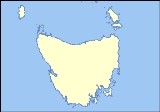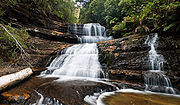
Mount Field National Park
Encyclopedia
Mount Field National Park is a national park in Tasmania
, Australia
, 64 km northwest of Hobart. The landscape ranges from eucalyptus
temperate rainforest to alpine moorland, rising to 1,434 metres (4,705 ft) at the summit of Mount Field West.
, Tasmania's oldest national park. The area around Russell Falls has been protected for its natural beauty since 1885, when it was set aside as Tasmania's first nature reserve. The last known wild thylacine
was captured in the region in 1933. The reserve was called "National Park" before 1946, but was officially renamed to its present name in 1947.
period a snowfield covered the top of the Mount Field plateau which fed glaciers in the surrounding valleys. A large, 12 km long glacier formed the broad river valley and the cirque walls above Lake Seal. Twisted Tarn, Twilight Tarn and the tarns on the tarn shelf were formed by glacial scouring. A glacier flowed south from the Rodway Range, forming lakes Belcher and Nelton, and north to form the Hayes Valley and Lake Hayes.
 In alpine areas podzolic, humus and leached soil is most common. The podzols often occur on deep periglacial solifluction deposits down to . Alluvial floodplains have developed in the lower park on deposits of quaternary alluvium.
In alpine areas podzolic, humus and leached soil is most common. The podzols often occur on deep periglacial solifluction deposits down to . Alluvial floodplains have developed in the lower park on deposits of quaternary alluvium.
.
Beside the Visitor Centre there are picnic and barbecue
facilities, as well as a playground and public toilets.


Walks from the Lake Dobson car park include:
Mount Field National park has one of Tasmania's downhill skiing areas. There are three ski tows, two on Mount Mawson and one on the Rodway range. There is generally sufficient snow cover for skiing from mid July to mid September.
Tasmania
Tasmania is an Australian island and state. It is south of the continent, separated by Bass Strait. The state includes the island of Tasmania—the 26th largest island in the world—and the surrounding islands. The state has a population of 507,626 , of whom almost half reside in the greater Hobart...
, Australia
Australia
Australia , officially the Commonwealth of Australia, is a country in the Southern Hemisphere comprising the mainland of the Australian continent, the island of Tasmania, and numerous smaller islands in the Indian and Pacific Oceans. It is the world's sixth-largest country by total area...
, 64 km northwest of Hobart. The landscape ranges from eucalyptus
Eucalyptus
Eucalyptus is a diverse genus of flowering trees in the myrtle family, Myrtaceae. Members of the genus dominate the tree flora of Australia...
temperate rainforest to alpine moorland, rising to 1,434 metres (4,705 ft) at the summit of Mount Field West.
History
Mount Field National Park was founded in 1916, making it, along with Freycinet National ParkFreycinet National Park
Freycinet is a national park on the east coast of Tasmania, Australia, 125 km northeast of Hobart. It occupies a large part of the Freycinet Peninsula, named after French navigator Louis de Freycinet, and Schouten Island....
, Tasmania's oldest national park. The area around Russell Falls has been protected for its natural beauty since 1885, when it was set aside as Tasmania's first nature reserve. The last known wild thylacine
Thylacine
The thylacine or ,also ;binomial name: Thylacinus cynocephalus, Greek for "dog-headed pouched one") was the largest known carnivorous marsupial of modern times. It is commonly known as the Tasmanian tiger or the Tasmanian wolf...
was captured in the region in 1933. The reserve was called "National Park" before 1946, but was officially renamed to its present name in 1947.
Geology
During the PleistocenePleistocene
The Pleistocene is the epoch from 2,588,000 to 11,700 years BP that spans the world's recent period of repeated glaciations. The name pleistocene is derived from the Greek and ....
period a snowfield covered the top of the Mount Field plateau which fed glaciers in the surrounding valleys. A large, 12 km long glacier formed the broad river valley and the cirque walls above Lake Seal. Twisted Tarn, Twilight Tarn and the tarns on the tarn shelf were formed by glacial scouring. A glacier flowed south from the Rodway Range, forming lakes Belcher and Nelton, and north to form the Hayes Valley and Lake Hayes.

Fauna
The park has good representation of much of native Tasmanian fauna including Wombats, Platypuses, eastern barred bandicoots, echidnas, and the Tasmanian devilTasmanian Devil
The Tasmanian devil is a carnivorous marsupial of the family Dasyuridae, now found in the wild only on the Australian island state of Tasmania. The size of a small dog, it became the largest carnivorous marsupial in the world following the extinction of the thylacine in 1936...
.
Accommodation and facilities
There is camping, with powered and unpowered sites at the entrance to the Park, as well as the Government-owned Lake Dobson cabins near the end of the access road within the Park. Several private ski/walking clubs have private huts, and a ski-lodge on the ski slopes has limited accommodation during the skiing season.Beside the Visitor Centre there are picnic and barbecue
Barbecue
Barbecue or barbeque , used chiefly in the United States, Canada, the United Kingdom, New Zealand and Australia is a method and apparatus for cooking meat, poultry and occasionally fish with the heat and hot smoke of a fire, smoking wood, or hot coals of...
facilities, as well as a playground and public toilets.
Activities
From the visitor centre:

- Russell FallsRussell FallsRussell Falls are located on the eastern boundary of Mount Field National Park, in Tasmania, Australia. Accessible by a paved walking track, the falls are a popular tourist attraction....
is an easy, 20 minute return walk on asphalt and boardwalks. - Horseshoe FallsHorseshoe Falls (Tasmania)Horseshoe Falls are located upstream of Russell Falls at Mount Field National Park, in Tasmania, Australia. The falls are a popular tourist attraction.Horseshoe Falls are composed of horizontal marine Permian siltstone benches, as are Russell Falls....
is a 30 minute walk. - The Lady Barron FallsLady Barron FallsLady Barron Falls is a cascading waterfall located within a few kilometres of Russell Falls in the Mount Field National Park. The waterfall is named after Lady Clara Barron, wife of Sir Harry Barron....
circuit (via Russell Falls and Horseshoe Falls) is approximately two hours return. - Tall Trees Walk is an easy thirty minute walk through the tall swamp gumEucalyptus regnansEucalyptus regnans, known variously by the common names Mountain Ash, Victorian Ash, Swamp Gum, Tasmanian Oak or Stringy Gum, is a species of Eucalyptus native to southeastern Australia, in Tasmania and Victoria...
s.
Walks from the Lake Dobson car park include:
- The Ski Lodge and Lake Seal lookout, one hour return.
- Seagers Lookout, two hours return.
- Mount Field East via Lake Nicholls, five hours return.
- Mount Field West, eight hours return.
- Tarn Shelf, Lake Newdegate, Twilight Tarn and Lake Webster circuit, six hours return.
Mount Field National park has one of Tasmania's downhill skiing areas. There are three ski tows, two on Mount Mawson and one on the Rodway range. There is generally sufficient snow cover for skiing from mid July to mid September.

